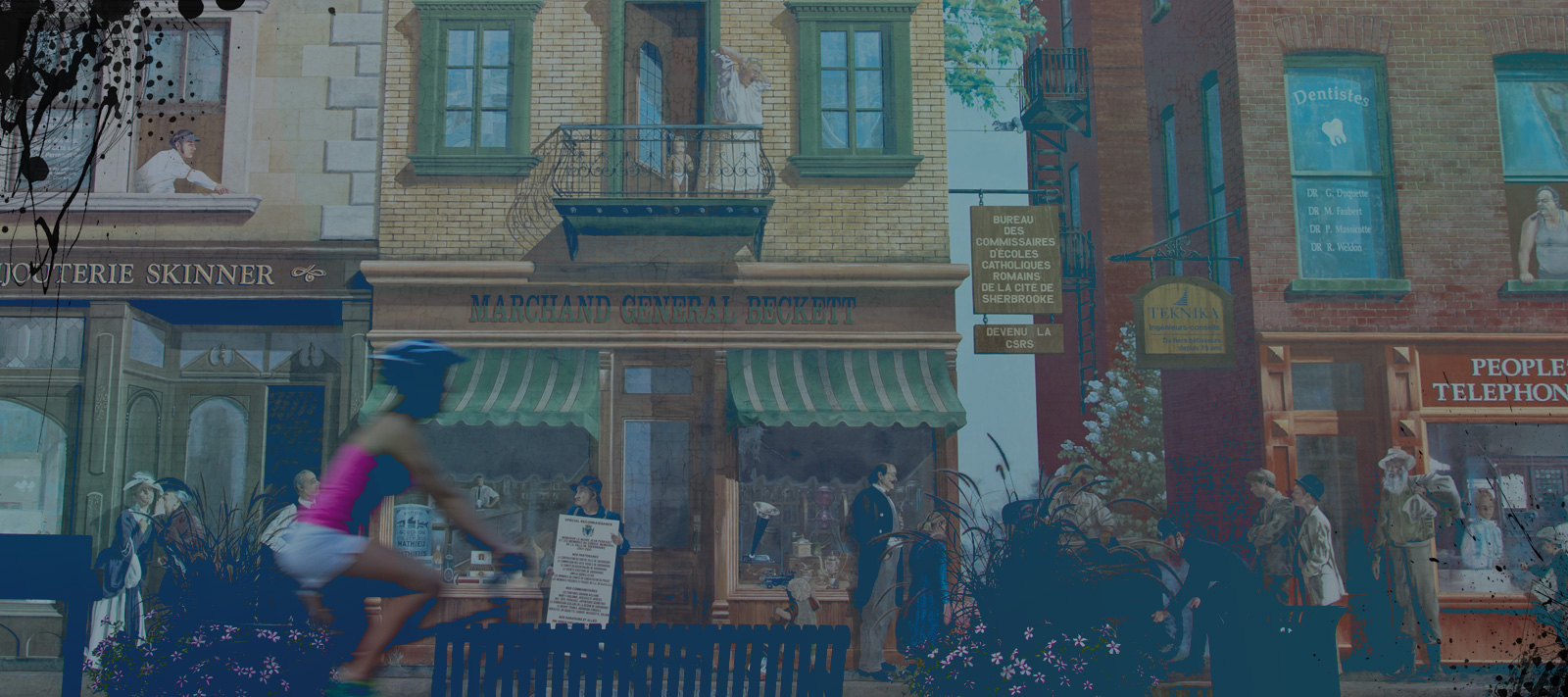-
Murales SherbrookeUne galerie d'art
à ciel ouvert!

Légendes et Mena'sen - EN
Legends & Mena’sen
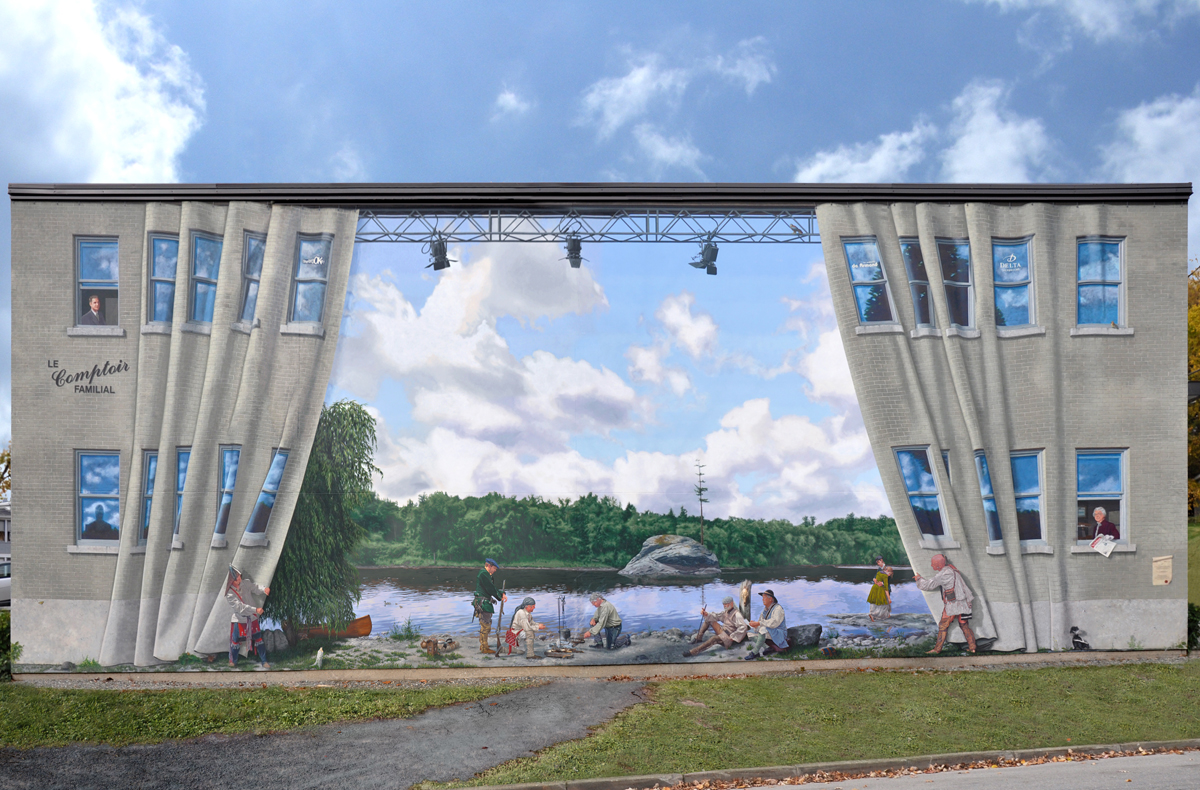
Dimensions : 68 by 29 feet
Year created : 2010
the mural in more detail ...
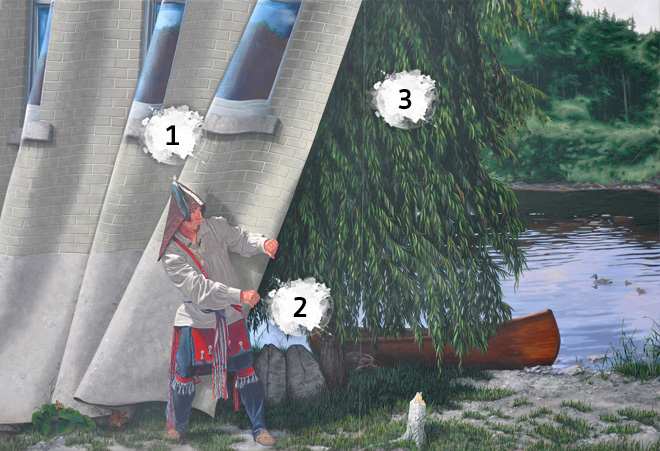 1
Abenaquis
Mr. Jacques Watso, in traditional Odanak garb, here illustrates the presence of First Nations in the area well before the first settlers came to the Eastern Townships.
2
Seminary Stones
In 1904, two stones bearing strange markings were discovered on the construction site of the Bromptonville church. They were handed over to the Séminaire Saint-Charles-Borromée. In 1966, specialists were unable to decipher them. In 1975, a Harvard University professor ventured that the inscriptions appeared to be written in a Libyan alphabet, but were in an ancient Egyptian dialect. The news attracted 18,000 visitors to the seminary museum. In 1977, Quebec’s minister of cultural affairs decided to call upon Université de Sherbrooke to help shed light on the matter. This led to a study revealing that the inscriptions were nothing more than the result of natural processes. They are currently housed at Sherbrooke’s Musée de la nature et des sciences.
3
The Willow’s Song
During the precolonial era, Gabriel Caron set out to farm the stretch of land along the shore of the Saint-François River between Sherbrooke and Lennoxville. Mr. Caron always admired a particular willow tree on his lands, whose branches waded in the water. The sounds of the wind in its leaves always seemed to bear a mysterious message. One night, dark clouds covered up the sky and lightning struck, ravaging the countryside. Mr. Caron sought refuge under the willow, but was overcome with a strange sensation. The willow’s song seemed to get louder and louder, and he was pushed by some force greater than himself to cry out, “the willow demands that we colonize further and conquer the Eastern Townships!” After the ordeal, this courageous man continually supported all those who would listen to the willow’s call. He planted willow branches on roads and local fields, teaching that these fast-growing trees quickly provide shade, withstand storms, and keep disaster at bay.
1
Abenaquis
Mr. Jacques Watso, in traditional Odanak garb, here illustrates the presence of First Nations in the area well before the first settlers came to the Eastern Townships.
2
Seminary Stones
In 1904, two stones bearing strange markings were discovered on the construction site of the Bromptonville church. They were handed over to the Séminaire Saint-Charles-Borromée. In 1966, specialists were unable to decipher them. In 1975, a Harvard University professor ventured that the inscriptions appeared to be written in a Libyan alphabet, but were in an ancient Egyptian dialect. The news attracted 18,000 visitors to the seminary museum. In 1977, Quebec’s minister of cultural affairs decided to call upon Université de Sherbrooke to help shed light on the matter. This led to a study revealing that the inscriptions were nothing more than the result of natural processes. They are currently housed at Sherbrooke’s Musée de la nature et des sciences.
3
The Willow’s Song
During the precolonial era, Gabriel Caron set out to farm the stretch of land along the shore of the Saint-François River between Sherbrooke and Lennoxville. Mr. Caron always admired a particular willow tree on his lands, whose branches waded in the water. The sounds of the wind in its leaves always seemed to bear a mysterious message. One night, dark clouds covered up the sky and lightning struck, ravaging the countryside. Mr. Caron sought refuge under the willow, but was overcome with a strange sensation. The willow’s song seemed to get louder and louder, and he was pushed by some force greater than himself to cry out, “the willow demands that we colonize further and conquer the Eastern Townships!” After the ordeal, this courageous man continually supported all those who would listen to the willow’s call. He planted willow branches on roads and local fields, teaching that these fast-growing trees quickly provide shade, withstand storms, and keep disaster at bay.
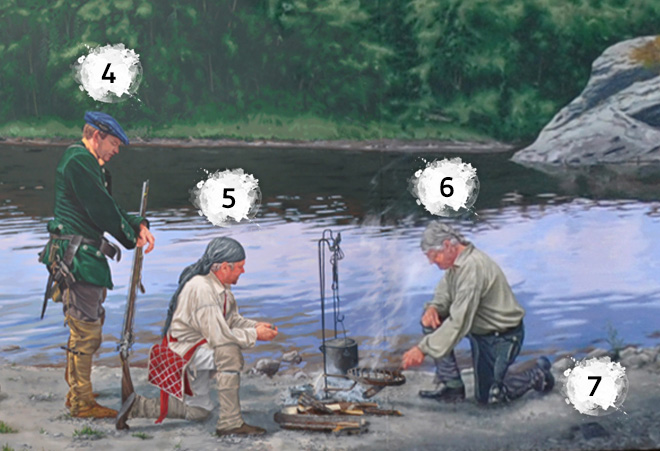 4
The Rangers in Sherbrooke
After the Capitulation of Quebec on September 18th, 1759, the British General Amherst ordered Major Robert Rogers to wipe out the Abenaki Villages before returning south of the border. Rogers led a well-known group of militiamen from Connecticut known as the “Rangers.” The Rangers massacred and burned down the village, which was located at the mouth of the Saint-François River. In spite of his victory at Odanak, Rogers was not out of the woods yet; he had destroyed a village, but not the Abenaki nation.
5/6
Adventurers
When the French disembarked in what would become New France, the Saint-François River soon became viewed as a strategic route—a navigable highway—fated to play a key role in our region’s history and even beyond our borders.
4
The Rangers in Sherbrooke
After the Capitulation of Quebec on September 18th, 1759, the British General Amherst ordered Major Robert Rogers to wipe out the Abenaki Villages before returning south of the border. Rogers led a well-known group of militiamen from Connecticut known as the “Rangers.” The Rangers massacred and burned down the village, which was located at the mouth of the Saint-François River. In spite of his victory at Odanak, Rogers was not out of the woods yet; he had destroyed a village, but not the Abenaki nation.
5/6
Adventurers
When the French disembarked in what would become New France, the Saint-François River soon became viewed as a strategic route—a navigable highway—fated to play a key role in our region’s history and even beyond our borders.
Starting in 1690, during the war between France and England, Governor Frontenac gave François Hertel a guerilla mission to destroy the village of Salmon Falls, New Hampshire. On March 29 of the same year, Hertel, accompanied by a few militiamen and Abenaki warriors, travelled the Saint-François and then Magog Rivers, and burned the village down. Hertel’s mission was successful.
In 1708, the war resumed, and the Saint-François once more took on a strategic role. Ever faithful to his strategy of foraying into enemy territory, Governor Vaudreuil appointed François Hertel’s son, Hertel de Rouville, to go on a new mission. Hertel took to the river with the aim or raiding Haverhill, an English colony in Massachusetts, on the Merrimack. This raid, too, was successful.
These missions were not military feats in themselves, but were strategically aimed at spreading terror in enemy territory. The inhabitants of the English colonies lived in constant fear of these raids, precisely because they lacked control of the river. The French and Abenaki warriors could strike at any point beyond the “Border.”
7
Traces of Native Americans
Archaeological excavations have turned up a number of artifacts in the area and at the confluence of the Magog and Saint-François Rivers, such as stone markers, arrowheads and pottery shards. These objects hark back to the presence of the Abenaki and Iroquois here.
 8
Mena’sen (rocky islet)
Since time immemorial, First Nations performed ritual ceremonies around this rock to invoke good fortune for their expeditions. The rock is reminiscent of a giant turtle with its massive shell emerging from the waters of the Saint-François River. The turtle is the oldest Native American symbol, representing the earth and the creation of the world.
8
Mena’sen (rocky islet)
Since time immemorial, First Nations performed ritual ceremonies around this rock to invoke good fortune for their expeditions. The rock is reminiscent of a giant turtle with its massive shell emerging from the waters of the Saint-François River. The turtle is the oldest Native American symbol, representing the earth and the creation of the world.
A particularly harsh February in the winter of 1692 forced the Iroquois to push beyond their usual hunting territory. They soon came face-to-face with the Abenaki at the confluence of the Magog and Saint-François Rivers. The two camps, equal in number, faced off nervously, steeling themselves for an attack. Before resorting to arms, the chiefs convened, and it was decided to avoid a bloody fight by pitting the best two respective warriors from each clan against each other in a unique battle—to race around the rock with the solitary pine. The most resilient runner would win the race, and his camp would take possession of the Alsiganteka territory. The runners chased each other around the frozen islet for hours before, at last, the Iroquois fell. His fellow warriors fell back in turn, acknowledging the Abenaki as the winners.
9
Explorer
The Saint-François River was not only a strategic route for invaders, but a rich source of natural resources.
In 1742, the governor of New France, Beauharnois, dispatched Noël Traversy and François Marais on a reconnaissance mission to survey the local forest and its resources. Louis XV hoped to exploit these resources to rebuild the French navy. In the course of their expedition, Traversy and Marais came upon Kitné, which was the name of the Grandes-Fourches site at the time. A few trappers’ and settlers’ cabins popped up, as settlers attempted to cultivate the land. Traversy’s mission was a resounding success, although later on, starting in 1807, it is the English who would exploit these rich forests for their own supplies. Their logging would benefit the Royal Navy and help grow the English empire. It was the New France explorers who gave the site its name: Grandes-Fourches.
10
Hiding Place
The deer skull hung up on the tree stump was a sign for the First Nations, indicating the presence of hidden supplies for the Abenaki. At the foot of the tree lay a bundle of food reserves for travellers.
11
Surveyor
The likes of Barlett, Coburn and Bouchette all traveled along this river to survey our beautiful region. Seen here is Joseph Bouchette, born on May 14th, 1774 in Quebec City, who was appointed Surveyor General of Lower Canada in 1803 after having conducted many major research projects in Upper Canada. He devoted much effort to surveying the border between Canada and the New England states. He also played an active role in the war of 1812. He additionally wrote and illustrated the oldest and one of the most comprehensive reference works on the topography of Lower Canada. One of his brilliant maps is of Ascot Township and Orford, i.e., Hyatt’s Mills, in 1828.
12
Black Stone
Some stories, even if not legendary, help paint a picture of our region’s not-so-distant past. Recovered messages, especially fragments of maps, show the beginning of a new phase in the frontier’s territory when the Europeans began to settle in the Eastern Townships. These scribbled fragments of letters and maps bear naïve markings, including of the black stone, or the savages’ cabin. Were they left behind by explorers, trappers or fur traders? Regardless of their authenticity, these documents evoke the touching simplicity of a bygone past.
13
Bossuet’s Treasure
Letters dating to 1796 seem to point to a real-life treasure hunt in the Hyatt’s Mills area in spite of the surveillance of the loyalists. The letters are said to have been written by a J. B. Bossuet, who inherited his father’s fortune in 1793. As the story goes, the loyalists were on to Bossuet, so he tried to convince them that his gold had been lost to the St. Lawrence River along with the ship Le Marie-Reine des Eaux. But the letter says that the fortune is safely hidden away and will remain so until someone finds it. These documents were reportedly secreted in the lining of a sea chest acquired at an auction by Jean-Claude Camiré for 25 cents. The letters were then turned over to Louis-Philippe Demers, director of the Office municipal du tourisme, but in spite of research by historians, genealogists and archivists from Quebec City, Ottawa and even Europe, no trace was found of a J. B. Bossuet… Perhaps it was a pseudonym.
What became of Bossuet’s treasure? Could the gold still be hidden away somewhere in Sherbrooke?
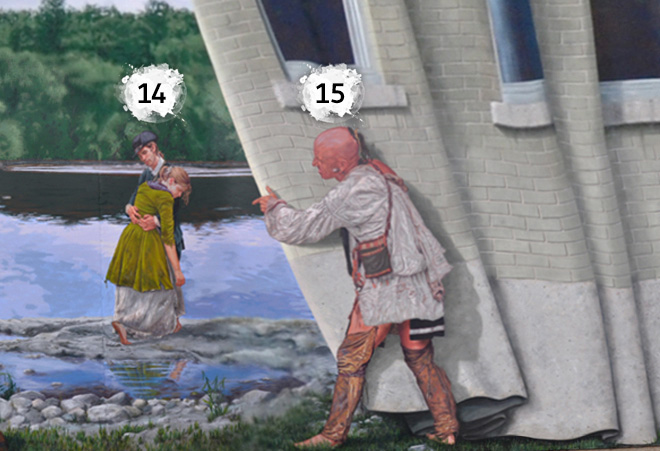 14
The Betrothed of Mena’sen
In 1904, Oscar Masse, a former resident of Sherbrooke, wrote a book entitled Mena’sen, an Abenaki name meaning “rock of the solitary pine.”
14
The Betrothed of Mena’sen
In 1904, Oscar Masse, a former resident of Sherbrooke, wrote a book entitled Mena’sen, an Abenaki name meaning “rock of the solitary pine.”
The book tells the tale of the young engaged couple of blacksmith Robert Gardner and Aline Morton, leading a peaceful and hope-filled life in Deerfield, Massachusetts (New England). In February 1704, this quiet life was shattered when their village came under attack by the French and Abenaki, who took some 100 prisoners, including the fiancés. For months, they were forcefully marched to Canada, where they were to be sold off. They were kept prisoners at Saint-François-du-Lac, but managed to escape. Exhausted, the young fiancée died in her beloved’s arms on our rock. To keep her body safe from predators, Gardner buried her in a crack in the rock, and covered her with moss and lichen. He planted a small pine tree as a tombstone, before succumbing to exhaustion himself and being carried away by the river.
According to the legend, the solitary pine grew out of the fiancée’s heart. What is known for sure is that the pine grew on the side of the rock shielded from the ice making its way downriver. It survived for more than 200 years in spite of many storms. Today it is no more; it disappeared in 1913 after being cut down by two drunk men who sold the tree slices as 25-cent souvenirs.
In 1934, in its place, the Société Saint-Jean-Baptiste de Sherbrooke erected a steel cross crafted in the workshops of J. S. Bourque to highlight the 400th anniversary of the discovery of Canada by Jacques Cartier. In May of 1936, the Société Saint-Jean-Baptiste de Sherbrooke was ceded the rights to the rock by the government of Quebec. In 1989, the City of Sherbrooke undertook to keep the cross permanently lit. In 2002, a new pine was planted in the same spot by Yvon Mercier, an Abenaki chief in Sherbrooke, to celebrate the city’s bicentennial. This symbol of the city has been illustrated hundreds of times over the years. A good example can be found on the premises of Sercovie, which feature a theatre tapestry made in the 1900s. It has been under restoration by Alphonse Cloutier for several years.
15
Iroquois
The Iroquois lived in the northeastern United States, south of Lake Ontario and the St. Lawrence River. They were a semi-sedentary farming people who supplemented their diet with fish and game. Known as skilled craftsmen, they wore animal skin clothing sown with porcupine quills and adorned with shells and motifs. Their original lands were the Adirondacks and Niagara Falls. Traces of their log houses have been dated back to the 10th century B.C.
During the Franco-British war, the Iroquois attacked the French, their Abenaki allies and the Hurons. Ultimately, they weakened the Huron Confederacy, which dispersed. Some of their prisoners were adopted and became Iroquois, whereas others were killed or sold.
In spite of their alliances and their war efforts in the history of North America, the First Nations were forced to cede their ancestral lands and, to this day, mostly live on reserves.
 16
Mr. Louis Georges Carignan
Mr. Louis Georges Carignan worked with priest Desève Cormier and several others to establish a discount clothing store for lower-income residents and disaster victims in Sherbrooke.
17
Comptoir familial
The Comptoir familial, a community-based discount store, was created in 1959. It continues to fulfil its mission of solidarity and reuse to this day. Thanks to its 105 volunteers, this unsubsidized organization has been able to generate profits thanks to sales of clothing and objects given to it by the community. The proceeds are then distributed to other organizations in need.
16
Mr. Louis Georges Carignan
Mr. Louis Georges Carignan worked with priest Desève Cormier and several others to establish a discount clothing store for lower-income residents and disaster victims in Sherbrooke.
17
Comptoir familial
The Comptoir familial, a community-based discount store, was created in 1959. It continues to fulfil its mission of solidarity and reuse to this day. Thanks to its 105 volunteers, this unsubsidized organization has been able to generate profits thanks to sales of clothing and objects given to it by the community. The proceeds are then distributed to other organizations in need.
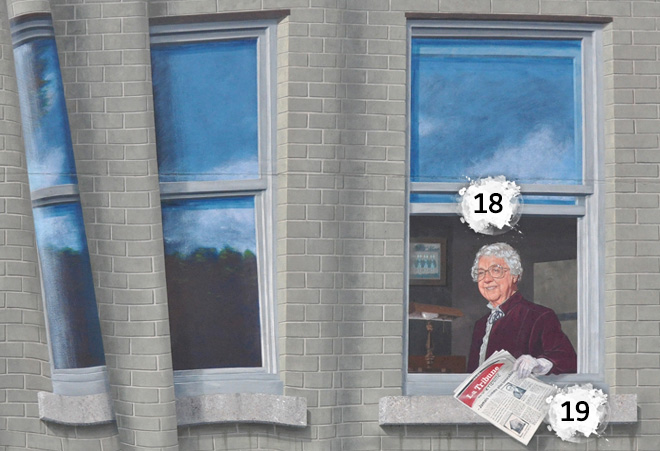 18
Madame Thérèse-Lefebvre
In the window, in the lower right-hand corner of the mural, is Thérèse-Lefebvre, born in Weedon in 1909. Her family settled in Sherbrooke in 1919. She is closely associated with the Sercovie organization (founded in 1973), which she presided from 1981 until her death in 1995. In 1991, she was named Sherbrooke’s volunteer of the year. Behind her is a frame showing the former mural painted on this same wall in the 1970s.
19
La Tribune
Lefebvre is holding the newspaper La Tribune, which celebrated its 100-year anniversary in 2010. The newspaper was created by Jacob Nicol. Nicol was born in Roxton Pond and studied law before practicing as a lawyer in Sherbrooke. Noticing the growing French-speaking population in Estrie, he decided to found La Tribune de Sherbrooke, which released its first paper on February 21st, 1910. Starting in the fall of 1921, he embarked on a lengthy political career. Even so, Nicol remained very active in the private sphere as the director of several insurance companies and the president of the radio stations CHLN (Trois-Rivières) and CHLT (Sherbrooke). He passed away in Sherbrooke in 1958.
18
Madame Thérèse-Lefebvre
In the window, in the lower right-hand corner of the mural, is Thérèse-Lefebvre, born in Weedon in 1909. Her family settled in Sherbrooke in 1919. She is closely associated with the Sercovie organization (founded in 1973), which she presided from 1981 until her death in 1995. In 1991, she was named Sherbrooke’s volunteer of the year. Behind her is a frame showing the former mural painted on this same wall in the 1970s.
19
La Tribune
Lefebvre is holding the newspaper La Tribune, which celebrated its 100-year anniversary in 2010. The newspaper was created by Jacob Nicol. Nicol was born in Roxton Pond and studied law before practicing as a lawyer in Sherbrooke. Noticing the growing French-speaking population in Estrie, he decided to found La Tribune de Sherbrooke, which released its first paper on February 21st, 1910. Starting in the fall of 1921, he embarked on a lengthy political career. Even so, Nicol remained very active in the private sphere as the director of several insurance companies and the president of the radio stations CHLN (Trois-Rivières) and CHLT (Sherbrooke). He passed away in Sherbrooke in 1958.

1
Abenaquis
Mr. Jacques Watso, in traditional Odanak garb, here illustrates the presence of First Nations in the area well before the first settlers came to the Eastern Townships.
2
Seminary Stones
In 1904, two stones bearing strange markings were discovered on the construction site of the Bromptonville church. They were handed over to the Séminaire Saint-Charles-Borromée. In 1966, specialists were unable to decipher them. In 1975, a Harvard University professor ventured that the inscriptions appeared to be written in a Libyan alphabet, but were in an ancient Egyptian dialect. The news attracted 18,000 visitors to the seminary museum. In 1977, Quebec’s minister of cultural affairs decided to call upon Université de Sherbrooke to help shed light on the matter. This led to a study revealing that the inscriptions were nothing more than the result of natural processes. They are currently housed at Sherbrooke’s Musée de la nature et des sciences.
3
The Willow’s Song
During the precolonial era, Gabriel Caron set out to farm the stretch of land along the shore of the Saint-François River between Sherbrooke and Lennoxville. Mr. Caron always admired a particular willow tree on his lands, whose branches waded in the water. The sounds of the wind in its leaves always seemed to bear a mysterious message. One night, dark clouds covered up the sky and lightning struck, ravaging the countryside. Mr. Caron sought refuge under the willow, but was overcome with a strange sensation. The willow’s song seemed to get louder and louder, and he was pushed by some force greater than himself to cry out, “the willow demands that we colonize further and conquer the Eastern Townships!” After the ordeal, this courageous man continually supported all those who would listen to the willow’s call. He planted willow branches on roads and local fields, teaching that these fast-growing trees quickly provide shade, withstand storms, and keep disaster at bay.

4
The Rangers in Sherbrooke
After the Capitulation of Quebec on September 18th, 1759, the British General Amherst ordered Major Robert Rogers to wipe out the Abenaki Villages before returning south of the border. Rogers led a well-known group of militiamen from Connecticut known as the “Rangers.” The Rangers massacred and burned down the village, which was located at the mouth of the Saint-François River. In spite of his victory at Odanak, Rogers was not out of the woods yet; he had destroyed a village, but not the Abenaki nation.
5/6
Adventurers
When the French disembarked in what would become New France, the Saint-François River soon became viewed as a strategic route—a navigable highway—fated to play a key role in our region’s history and even beyond our borders.
Starting in 1690, during the war between France and England, Governor Frontenac gave François Hertel a guerilla mission to destroy the village of Salmon Falls, New Hampshire. On March 29 of the same year, Hertel, accompanied by a few militiamen and Abenaki warriors, travelled the Saint-François and then Magog Rivers, and burned the village down. Hertel’s mission was successful.
In 1708, the war resumed, and the Saint-François once more took on a strategic role. Ever faithful to his strategy of foraying into enemy territory, Governor Vaudreuil appointed François Hertel’s son, Hertel de Rouville, to go on a new mission. Hertel took to the river with the aim or raiding Haverhill, an English colony in Massachusetts, on the Merrimack. This raid, too, was successful.
These missions were not military feats in themselves, but were strategically aimed at spreading terror in enemy territory. The inhabitants of the English colonies lived in constant fear of these raids, precisely because they lacked control of the river. The French and Abenaki warriors could strike at any point beyond the “Border.”
Starting in 1690, during the war between France and England, Governor Frontenac gave François Hertel a guerilla mission to destroy the village of Salmon Falls, New Hampshire. On March 29 of the same year, Hertel, accompanied by a few militiamen and Abenaki warriors, travelled the Saint-François and then Magog Rivers, and burned the village down. Hertel’s mission was successful.
In 1708, the war resumed, and the Saint-François once more took on a strategic role. Ever faithful to his strategy of foraying into enemy territory, Governor Vaudreuil appointed François Hertel’s son, Hertel de Rouville, to go on a new mission. Hertel took to the river with the aim or raiding Haverhill, an English colony in Massachusetts, on the Merrimack. This raid, too, was successful.
These missions were not military feats in themselves, but were strategically aimed at spreading terror in enemy territory. The inhabitants of the English colonies lived in constant fear of these raids, precisely because they lacked control of the river. The French and Abenaki warriors could strike at any point beyond the “Border.”
7
Traces of Native Americans
Archaeological excavations have turned up a number of artifacts in the area and at the confluence of the Magog and Saint-François Rivers, such as stone markers, arrowheads and pottery shards. These objects hark back to the presence of the Abenaki and Iroquois here.

8
Mena’sen (rocky islet)
Since time immemorial, First Nations performed ritual ceremonies around this rock to invoke good fortune for their expeditions. The rock is reminiscent of a giant turtle with its massive shell emerging from the waters of the Saint-François River. The turtle is the oldest Native American symbol, representing the earth and the creation of the world.
A particularly harsh February in the winter of 1692 forced the Iroquois to push beyond their usual hunting territory. They soon came face-to-face with the Abenaki at the confluence of the Magog and Saint-François Rivers. The two camps, equal in number, faced off nervously, steeling themselves for an attack. Before resorting to arms, the chiefs convened, and it was decided to avoid a bloody fight by pitting the best two respective warriors from each clan against each other in a unique battle—to race around the rock with the solitary pine. The most resilient runner would win the race, and his camp would take possession of the Alsiganteka territory. The runners chased each other around the frozen islet for hours before, at last, the Iroquois fell. His fellow warriors fell back in turn, acknowledging the Abenaki as the winners.
A particularly harsh February in the winter of 1692 forced the Iroquois to push beyond their usual hunting territory. They soon came face-to-face with the Abenaki at the confluence of the Magog and Saint-François Rivers. The two camps, equal in number, faced off nervously, steeling themselves for an attack. Before resorting to arms, the chiefs convened, and it was decided to avoid a bloody fight by pitting the best two respective warriors from each clan against each other in a unique battle—to race around the rock with the solitary pine. The most resilient runner would win the race, and his camp would take possession of the Alsiganteka territory. The runners chased each other around the frozen islet for hours before, at last, the Iroquois fell. His fellow warriors fell back in turn, acknowledging the Abenaki as the winners.
9
Explorer
The Saint-François River was not only a strategic route for invaders, but a rich source of natural resources.
In 1742, the governor of New France, Beauharnois, dispatched Noël Traversy and François Marais on a reconnaissance mission to survey the local forest and its resources. Louis XV hoped to exploit these resources to rebuild the French navy. In the course of their expedition, Traversy and Marais came upon Kitné, which was the name of the Grandes-Fourches site at the time. A few trappers’ and settlers’ cabins popped up, as settlers attempted to cultivate the land. Traversy’s mission was a resounding success, although later on, starting in 1807, it is the English who would exploit these rich forests for their own supplies. Their logging would benefit the Royal Navy and help grow the English empire. It was the New France explorers who gave the site its name: Grandes-Fourches.
In 1742, the governor of New France, Beauharnois, dispatched Noël Traversy and François Marais on a reconnaissance mission to survey the local forest and its resources. Louis XV hoped to exploit these resources to rebuild the French navy. In the course of their expedition, Traversy and Marais came upon Kitné, which was the name of the Grandes-Fourches site at the time. A few trappers’ and settlers’ cabins popped up, as settlers attempted to cultivate the land. Traversy’s mission was a resounding success, although later on, starting in 1807, it is the English who would exploit these rich forests for their own supplies. Their logging would benefit the Royal Navy and help grow the English empire. It was the New France explorers who gave the site its name: Grandes-Fourches.
10
Hiding Place
The deer skull hung up on the tree stump was a sign for the First Nations, indicating the presence of hidden supplies for the Abenaki. At the foot of the tree lay a bundle of food reserves for travellers.
11
Surveyor
The likes of Barlett, Coburn and Bouchette all traveled along this river to survey our beautiful region. Seen here is Joseph Bouchette, born on May 14th, 1774 in Quebec City, who was appointed Surveyor General of Lower Canada in 1803 after having conducted many major research projects in Upper Canada. He devoted much effort to surveying the border between Canada and the New England states. He also played an active role in the war of 1812. He additionally wrote and illustrated the oldest and one of the most comprehensive reference works on the topography of Lower Canada. One of his brilliant maps is of Ascot Township and Orford, i.e., Hyatt’s Mills, in 1828.
12
Black Stone
Some stories, even if not legendary, help paint a picture of our region’s not-so-distant past. Recovered messages, especially fragments of maps, show the beginning of a new phase in the frontier’s territory when the Europeans began to settle in the Eastern Townships. These scribbled fragments of letters and maps bear naïve markings, including of the black stone, or the savages’ cabin. Were they left behind by explorers, trappers or fur traders? Regardless of their authenticity, these documents evoke the touching simplicity of a bygone past.
13
Bossuet’s Treasure
Letters dating to 1796 seem to point to a real-life treasure hunt in the Hyatt’s Mills area in spite of the surveillance of the loyalists. The letters are said to have been written by a J. B. Bossuet, who inherited his father’s fortune in 1793. As the story goes, the loyalists were on to Bossuet, so he tried to convince them that his gold had been lost to the St. Lawrence River along with the ship Le Marie-Reine des Eaux. But the letter says that the fortune is safely hidden away and will remain so until someone finds it. These documents were reportedly secreted in the lining of a sea chest acquired at an auction by Jean-Claude Camiré for 25 cents. The letters were then turned over to Louis-Philippe Demers, director of the Office municipal du tourisme, but in spite of research by historians, genealogists and archivists from Quebec City, Ottawa and even Europe, no trace was found of a J. B. Bossuet… Perhaps it was a pseudonym.
What became of Bossuet’s treasure? Could the gold still be hidden away somewhere in Sherbrooke?
What became of Bossuet’s treasure? Could the gold still be hidden away somewhere in Sherbrooke?

14
The Betrothed of Mena’sen
In 1904, Oscar Masse, a former resident of Sherbrooke, wrote a book entitled Mena’sen, an Abenaki name meaning “rock of the solitary pine.”
The book tells the tale of the young engaged couple of blacksmith Robert Gardner and Aline Morton, leading a peaceful and hope-filled life in Deerfield, Massachusetts (New England). In February 1704, this quiet life was shattered when their village came under attack by the French and Abenaki, who took some 100 prisoners, including the fiancés. For months, they were forcefully marched to Canada, where they were to be sold off. They were kept prisoners at Saint-François-du-Lac, but managed to escape. Exhausted, the young fiancée died in her beloved’s arms on our rock. To keep her body safe from predators, Gardner buried her in a crack in the rock, and covered her with moss and lichen. He planted a small pine tree as a tombstone, before succumbing to exhaustion himself and being carried away by the river.
According to the legend, the solitary pine grew out of the fiancée’s heart. What is known for sure is that the pine grew on the side of the rock shielded from the ice making its way downriver. It survived for more than 200 years in spite of many storms. Today it is no more; it disappeared in 1913 after being cut down by two drunk men who sold the tree slices as 25-cent souvenirs.
In 1934, in its place, the Société Saint-Jean-Baptiste de Sherbrooke erected a steel cross crafted in the workshops of J. S. Bourque to highlight the 400th anniversary of the discovery of Canada by Jacques Cartier. In May of 1936, the Société Saint-Jean-Baptiste de Sherbrooke was ceded the rights to the rock by the government of Quebec. In 1989, the City of Sherbrooke undertook to keep the cross permanently lit. In 2002, a new pine was planted in the same spot by Yvon Mercier, an Abenaki chief in Sherbrooke, to celebrate the city’s bicentennial. This symbol of the city has been illustrated hundreds of times over the years. A good example can be found on the premises of Sercovie, which feature a theatre tapestry made in the 1900s. It has been under restoration by Alphonse Cloutier for several years.
The book tells the tale of the young engaged couple of blacksmith Robert Gardner and Aline Morton, leading a peaceful and hope-filled life in Deerfield, Massachusetts (New England). In February 1704, this quiet life was shattered when their village came under attack by the French and Abenaki, who took some 100 prisoners, including the fiancés. For months, they were forcefully marched to Canada, where they were to be sold off. They were kept prisoners at Saint-François-du-Lac, but managed to escape. Exhausted, the young fiancée died in her beloved’s arms on our rock. To keep her body safe from predators, Gardner buried her in a crack in the rock, and covered her with moss and lichen. He planted a small pine tree as a tombstone, before succumbing to exhaustion himself and being carried away by the river.
According to the legend, the solitary pine grew out of the fiancée’s heart. What is known for sure is that the pine grew on the side of the rock shielded from the ice making its way downriver. It survived for more than 200 years in spite of many storms. Today it is no more; it disappeared in 1913 after being cut down by two drunk men who sold the tree slices as 25-cent souvenirs.
In 1934, in its place, the Société Saint-Jean-Baptiste de Sherbrooke erected a steel cross crafted in the workshops of J. S. Bourque to highlight the 400th anniversary of the discovery of Canada by Jacques Cartier. In May of 1936, the Société Saint-Jean-Baptiste de Sherbrooke was ceded the rights to the rock by the government of Quebec. In 1989, the City of Sherbrooke undertook to keep the cross permanently lit. In 2002, a new pine was planted in the same spot by Yvon Mercier, an Abenaki chief in Sherbrooke, to celebrate the city’s bicentennial. This symbol of the city has been illustrated hundreds of times over the years. A good example can be found on the premises of Sercovie, which feature a theatre tapestry made in the 1900s. It has been under restoration by Alphonse Cloutier for several years.
15
Iroquois
The Iroquois lived in the northeastern United States, south of Lake Ontario and the St. Lawrence River. They were a semi-sedentary farming people who supplemented their diet with fish and game. Known as skilled craftsmen, they wore animal skin clothing sown with porcupine quills and adorned with shells and motifs. Their original lands were the Adirondacks and Niagara Falls. Traces of their log houses have been dated back to the 10th century B.C.
During the Franco-British war, the Iroquois attacked the French, their Abenaki allies and the Hurons. Ultimately, they weakened the Huron Confederacy, which dispersed. Some of their prisoners were adopted and became Iroquois, whereas others were killed or sold.
In spite of their alliances and their war efforts in the history of North America, the First Nations were forced to cede their ancestral lands and, to this day, mostly live on reserves.
During the Franco-British war, the Iroquois attacked the French, their Abenaki allies and the Hurons. Ultimately, they weakened the Huron Confederacy, which dispersed. Some of their prisoners were adopted and became Iroquois, whereas others were killed or sold.
In spite of their alliances and their war efforts in the history of North America, the First Nations were forced to cede their ancestral lands and, to this day, mostly live on reserves.

16
Mr. Louis Georges Carignan
Mr. Louis Georges Carignan worked with priest Desève Cormier and several others to establish a discount clothing store for lower-income residents and disaster victims in Sherbrooke.
17
Comptoir familial
The Comptoir familial, a community-based discount store, was created in 1959. It continues to fulfil its mission of solidarity and reuse to this day. Thanks to its 105 volunteers, this unsubsidized organization has been able to generate profits thanks to sales of clothing and objects given to it by the community. The proceeds are then distributed to other organizations in need.

18
Madame Thérèse-Lefebvre
In the window, in the lower right-hand corner of the mural, is Thérèse-Lefebvre, born in Weedon in 1909. Her family settled in Sherbrooke in 1919. She is closely associated with the Sercovie organization (founded in 1973), which she presided from 1981 until her death in 1995. In 1991, she was named Sherbrooke’s volunteer of the year. Behind her is a frame showing the former mural painted on this same wall in the 1970s.
19
La Tribune
Lefebvre is holding the newspaper La Tribune, which celebrated its 100-year anniversary in 2010. The newspaper was created by Jacob Nicol. Nicol was born in Roxton Pond and studied law before practicing as a lawyer in Sherbrooke. Noticing the growing French-speaking population in Estrie, he decided to found La Tribune de Sherbrooke, which released its first paper on February 21st, 1910. Starting in the fall of 1921, he embarked on a lengthy political career. Even so, Nicol remained very active in the private sphere as the director of several insurance companies and the president of the radio stations CHLN (Trois-Rivières) and CHLT (Sherbrooke). He passed away in Sherbrooke in 1958.

